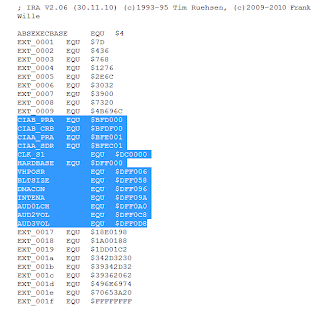IRA the dissembler again
Wow, it has started to piss me off, well not rally, what i considered as relative easy thing to do is not as easy as first thought.
The dissembler does good job at generating Assembly code, but does poor job as knowing the different between strings and assembly code, the challenge was not Assembly but cleaning up after a tornado.
What the dissembler generated:
LAB_0014:
BVS.S LAB_001C
MOVEQ #117,D2
BVS.S LAB_001F
DC.W $696f
BGT.S LAB_0018
DC.W $6c69
BHI.S LAB_0020
BSR.S LAB_0021
DC.W $7900
LAB_0015:
BEQ.S LAB_0022
BSR.S LAB_0022
DC.W $6869
DC.W $6373
MOVEA.L 26978(A4),A7
MOVEQ #97,D1
MOVEQ #121,D1
This should be:
LAB_0014_intuition_library:
DC.b "intuition.library",0
LAB_0015_library:
DC.b "graphics.library",0
You can see that some
thing went wrong when you see DC.w and DC.b mixed whit assembly its
not common, maybe if it was a undocumented machine code instruction.
Just to repeat my self, I
know some you who read this might not have written assembly so
explain it again, DC.b is for arrays of byte and string (array of bytes that has ascii values), DC.w is for
16bit Integer (WORD) of arrays.
“DS” is for size of
data and reserves chunk inside your code.
What you really need to
use to clean it up a good hex editor, so you can look inside the exe
file, and see what text strings should be.
I write a few commands to
help me find hex values.
hex_to_string and
string_to_hex, it's nice to have if you wonder if some thing really
is ASCII and not numbers.
Debugging
When debugging code one of
my favorite tools is PrintF, simply because debuggers don't work so
well under AmigaOS, we have grim repaper that displays power pc
registers and 680x0 emulated registers, and where it crashed, but
680x0 code its translated as program runs so its hard to know where
it crashed, and also grim only displays crash location as powerpc
assembly.
Under UAE there are
probably better tools, but I need to find the crashes under AmigaOS4,
not under UAE, so not that useful,
C vs Assembly language
Sorry I just don't get it, way are people (Franko) telling me that Assembly is easy language?
This window display C code that does the Dos.library / PrintF command just as Assembly code above.
Well the code lies, I should have opened the DOS.library but its no longer necessary under AmigaOS4, whit -lauto option, so not a big lie, it works as its written.
but as you can see Assembly version of printf takes up to 7 lines to do the same as C does in just ONE single line, and it does the same thing.
And also you can see that strings has to be put some where else, and then you need to move the values in to ARGS array (D2), before command is executed, it just allot of more work.
Well maybe Assembly is not
that complicated, but does require a lot more work, in the old days
it made sense to do it in Assembly because you needed to optimize for
speed as CPU's back then was slow, and you need to optimize for size
as storage space was critical, but today it makes no sense
to do it unless your optimizing something critical.






